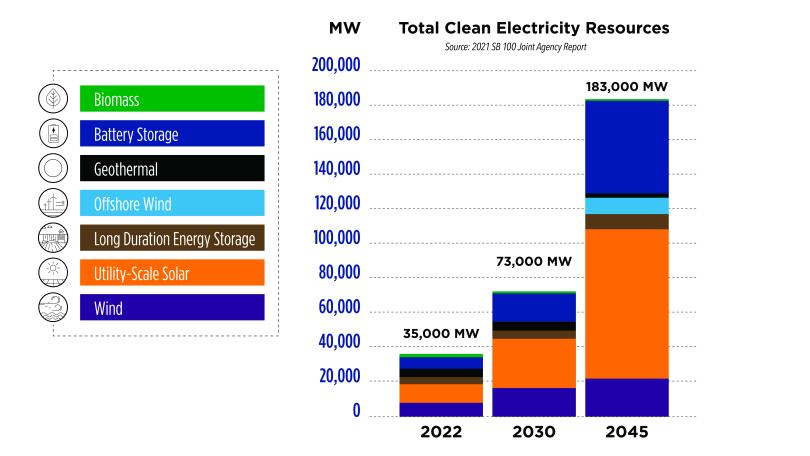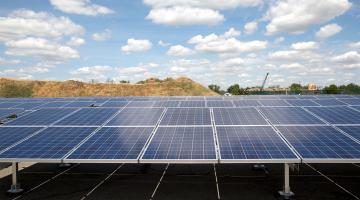The SB 100 Joint Agency Report includes:
- Policy review (technical, safety, affordability, reliability)
- Reliability benefits and impacts
- Financial costs and benefits
- Barriers and benefits of achieving the policy
- Alternative scenarios and costs/benefits of each
2025 SB 100 Joint Agency Report
The 2025 SB 100 Joint Agency Report builds on the 2021 Report and will:
- Report on current statewide efforts toward clean electricity progress and opportunities to enhance state efforts.
- Study alternate scenarios to understand impact of uncertainty in cost, technology innovation, and project development on achieving SB 100.
- Provide external engagement that is early, often, and meaningful.
- Capacity Expansion: developing the resource portfolio associated with each concept pathway
- Tools: EPRI’s REGEN model, PLEXOS Long Term Model
- Reliability and Production Cost Modeling: evaluating pathway portfolio’s ability to meet reliability standards and stressed supply conditions
- Tools: PLEXOS production cost model
- Workshops: See SB 100 Events
Newly developed clean energy scenarios evaluated to explore multiple factors and highlight tradeoffs, commonalities, and costs. Three demand scenarios will be used as inputs to the resource scenario analysis.
- Reference
Existing resource plans replace the base resource, including the CPUC’s Preferred System Plan through 2039, and POU Resource Plans. - Base
Least cost model based on current demand scenario and resource cost projections. Existing Resource Plans through 2030. - Minimum Compliance
Base scenario without constraints on GHG emissions. This scenario is focused on SB 100 compliance only. - DER Focus
Higher levels of distributed energy resources, including BTM and FTM generation and storage resources, and demand flexibility. - Resource Diversification
Procurement and technology advancements for a variety of existing and emerging resources able to be used for SB 100 compliance. - Geographic Diversification
Expanded regional transmission allowing for greater energy exchanges between California and the rest of the WECC. - Combustion Resource Retirement
Transition from combustion power plants to only non-combustion power plants - Workshops: See SB 100 Events
- Analyze projected land-use impacts of the scenario resource portfolios and opportunities to reduce environmental impacts.
- Environmental and Land Use considerations
- The scenario environmental and land use analysis will include an estimation of the land area and sea space required for the resource build in each scenario and then a high-level evaluation of projected environmental and land-use constraints using quantitative (mapbased datasets) and qualitative information.
- Environmental and Land Use considerations
- Workshops: See SB 100 Events
- Beyond the climate benefits of transitioning our energy system, additional environmental, social, and economic impacts are inherent in this large-scale transition.
- Written comments to the 2021 report recommended the joint agencies integrate at least the following NEIs into SB 100 planning: land use impacts, public health and air quality, water supply and quality, economic impacts, and resilience.
- Workshops: See SB 100 Events
External engagement is underway with balancing authorities, load-serving entities (IOUs, POUs, CCAs), local governments, tribal governments, environmental justice organizations, and interested public parties through workshops, working groups, consultations, and regional meetings both in-person and virtually.
2021 SB 100 Joint Agency Report
To achieve SB 100, California will build an unprecedented amount of new clean energy resources. The 2021 report recommended further analysis on 1) grid reliability, 2) emerging resources, and 3) environmental, social and economic cost and benefits.
The 2021 SB 100 Joint Agency Report is a first step to evaluate the challenges and opportunities in implementing SB 100. It includes an initial assessment of the additional energy resources and the resource building rates needed to achieve 100 percent clean electricity, along with the associated costs. It uses a computer model to analyze these factors under various conditions and technologies.
A diverse array of interests informed this report through a year-long series of public workshops and comment opportunities. The joint agencies also consulted with the California balancing authorities, as required by the statute, and the Disadvantaged Communities Advisory Group, which advises the Energy Commission and Public Utilities Commission on energy equity issues.
To provide 100% clean electricity by 2045, California will need to build an unprecedented amount of new utility-scale clean energy. In addition, California also expects new capacity from energy efficiency, customer solar and demand response. (Totals represent new and existing resources.)
- This initial analysis suggests SB 100 is technically achievable through multiple pathways.
- Construction of clean electricity generation and storage facilities must be sustained at record-setting rates.
- Diversity in energy resources and technologies lowers overall costs.
- Retaining some natural gas power capacity may minimize costs while ensuring uninterrupted power supply during the transition to 100 percent clean energy.
- Increased energy storage and advancements in zero-carbon technologies can reduce natural gas capacity needs.
- Further analysis is needed.
Modeling results indicate that achieving 100 percent clean electricity will increase the total annual electricity system costs by 6 percent relative to the cost under the state’s Renewables Portfolio Standard requirement of having at least 60 percent clean electricity by the end of 2030. These estimates will change over time as markets change, new technologies are commercialized, and additional factors such as grid reliability are included in future analyses.
- Verify that scenario results satisfy the state’s grid reliability requirements.
- Continue to evaluate the potential effects of emerging resources, such as offshore wind, long-duration energy storage, green hydrogen technologies, and demand flexibility.
- Assess environmental, social, and economic costs and benefits of the additional clean electricity generation capacity and storage needed to implement SB 100.
Hold annual workshops to support alignment among the joint agencies and continuity between SB 100 reports.


